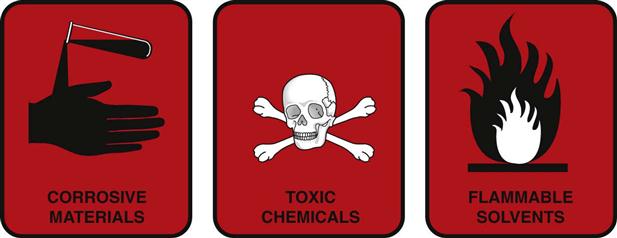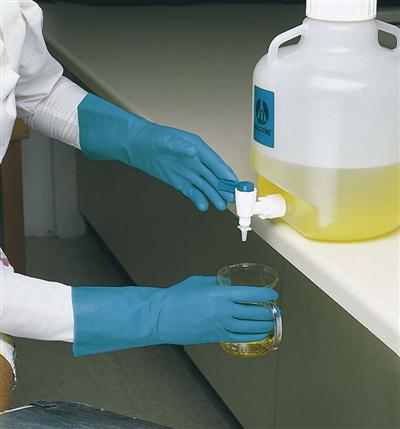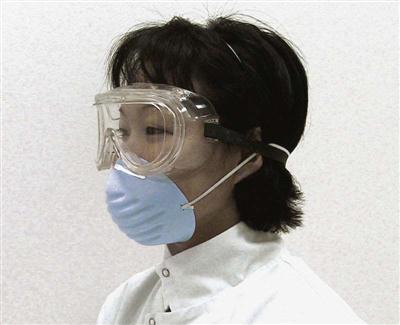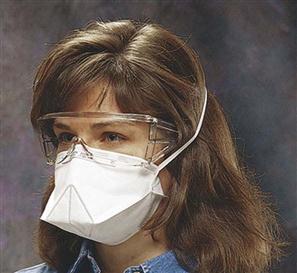Chemical and Waste Management
Learning Outcomes
On completion of this chapter, the student will be able to achieve the following objectives:
• Pronounce, define, and spell the Key Terms.
• Describe potential long-term and short-term effects of exposure to chemicals.
• Explain the purpose of the OSHA Hazard Communication Standard.
• Describe three common methods of chemical exposure.
• Describe the components of a hazard communication program.
• Explain the purpose of a material safety data sheet.
• Create a label for a secondary container.
• Describe the difference between chronic and acute chemical exposure.
• Identify four methods of personal protection against chemical exposure.
• Describe in general how chemicals should be stored.
• Explain the record-keeping requirements of the Hazard Communication Standard.
• Identify types of regulated waste generated in a dental office.
• Identify types of toxic waste generated in a dental office.
Performance Outcome
Upon completion of this chapter, the student will be able to meet competency standards in the following skill:
Electronic Resources
![]() Additional information related to content in Chapter 23 can be found on the companion Evolve Web site.
Additional information related to content in Chapter 23 can be found on the companion Evolve Web site.
Key Terms
Acute exposure High levels of exposure over a short period.
Chemical inventory Comprehensive list of every product used in the office that contains chemicals.
Chronic exposure Repeated exposures, generally to lower levels, over a long time.
Contaminated waste Items such as gloves and patient napkins that may contain the potentially infectious body fluids of patients.
Hazard Communication Standard Occupational Safety and Health Administration (OSHA) standard regarding employees’ “right to know” about chemicals in the workplace.
Hazardous waste Waste that poses a risk to humans or to the environment.
Infectious waste Waste that is capable of transmitting an infectious disease.
Material safety data sheet (MSDS) Form that provides health and safety information regarding materials that contain chemicals.
Regulated waste Infectious waste that requires special handling, neutralization, and disposal.
Toxic waste Waste that can have a poisonous effect.
In the day-to-day practice of dentistry, the dental assistant is exposed to a wide variety of chemicals. All chemicals that are used for treatment procedures, cleaning of instruments and surfaces, disinfection and sterilization, laboratory procedures, and dental x-ray processing are capable of causing serious health consequences if they are absorbed into the body in sufficiently large amounts.
The heart, kidney, liver, and lung tissues can be seriously damaged by chemicals. Results range from short-term discomfort, such as burns or rashes, to life-threatening conditions, such as cancer or organ failure.
As a dental assistant, it is important for you to understand the proper use, storage, handling, spill cleanup, and disposal methods for all chemicals used in the dental office. In addition, you should know the first aid procedures associated with chemicals. You must be aware of the hazardous materials that may be regulated under federal, state, or local environmental guidelines and the requirements associated with the disposal of these hazardous materials. Common examples of items that require special disposal procedures include x-ray processing solutions, lead foil backing from film packets, scrap dental amalgam, and elemental mercury.
This chapter also discusses the Occupational Safety and Health Administration (OSHA) Hazard Communication Standard and the procedures necessary to develop the safe working habits that will become part of your daily routine in the dental office.
Hazardous Chemicals
A hazardous chemical is defined as any chemical that can cause a physical or a health hazard. A chemical is considered hazardous if it (1) can ignite (catch fire), (2) can react or explode when mixed with other substances, (3) is corrosive, or (4) is toxic (Fig. 23-1).

Exposure to Chemicals
The three primary methods of chemical exposure are inhalation, skin contact, and ingestion.
Inhalation of the gases, vapors, or dusts of chemicals can cause direct damage to the lungs. Some chemicals may not affect the lungs but are absorbed by them and are then sent through the blood to other organs, such as the brain, liver, or kidneys, where they may cause damage.
Skin is an effective barrier against many chemicals, but some chemicals can be absorbed through the skin. In general, you must have direct skin contact with the chemical for absorption to occur. Sometimes, after repeated contact with a chemical, a skin condition called dermatitis may develop.
Ingestion (swallowing) is another way in which chemicals can enter the body. Common ways of ingesting harmful chemicals in the workplace include eating lunch in an area in which chemicals are used or eating with hands that are contaminated with chemicals. It is important to wash your hands thoroughly after contact with any chemical.
Acute and Chronic Chemical Toxicity
The potential for a chemical to cause harm and the extent of harm depend on the amount of the dose and the duration of exposure to the chemical. Chemical toxicity may be acute or chronic.
Acute chemical toxicity results from high levels of exposure over a short period. Acute toxicity is often caused by a chemical spill, in which exposure is sudden and often involves a large amount of the chemical.
The victim of acute toxicity feels the effects immediately. Dizziness, fainting, headache, nausea, and vomiting are symptoms of acute overexposure to chemicals.
Chronic chemical toxicity results from many repeated exposures, generally to lower levels, over a much longer time (months or even years). Many effects of chronic toxicity are possible, including liver disease, brain disorders, cancer, and infertility. Always check the material safety data sheet and the product label for information on potential dangers associated with the chemicals included in the products you use.
The difference between acute and chronic toxicity can be illustrated by considering the effects of acute exposure and chronic exposure to the same chemical. For example, a single exposure to a high concentration of benzene (acute toxicity) may cause dizziness, headache, and unconsciousness, whereas long-term daily exposure to low levels of benzene (chronic toxicity) may eventually cause leukemia.
Hand Protection
When using chemicals, be certain to wear utility gloves made from a chemical-resistant material, such as natural rubber, neoprene, or industrial grade nitrile (Fig. 23-2).
These chemical-resistant gloves are essential because the latex gloves worn during patient care do not provide adequate protection when one is handling chemicals. When exposed to chemical disinfectants, the latex in the glove degrades and creates a wicking (sucking) action that will actually pull contaminants and chemicals through the glove and onto the hands.
Eye Protection
Serious damage to the eyes, even blindness, can result from chemical accidents. It is crucial to protect the eyes from fumes and splashes while pouring chemicals such as x-ray processing solutions, ultrasonic solutions, disinfectants, and sterilants.
A variety of safety eyewear is available. The ideal goggles have soft, vinyl flanges (rims) at the top and bottom and fit the face snugly (Fig. 23-3).
Protective Clothing
When caustic or staining chemicals are used, it is best to wear a rubber or neoprene apron when mixing or pouring the chemical. The material safety data sheet (MSDS) for each product (see later discussion) provides specific information regarding the need for additional personal protective equipment (PPE).
Inhalation Protection
Depending on the quality, the masks worn during patient care may or may not provide adequate protection when one is working with chemicals. The proper face mask should be fluid repellent and should provide respiratory protection.
If your job requires you to pour or mix chemicals frequently, or if you are sensitive or allergic to substances, you might require a mist respirator face mask approved by the National Institute of Occupational Safety and Health (NIOSH) (Fig. 23-4).
Control of Chemical Spills
Accidents and spills should not be common occurrences. Planning and practice in dealing with such spills should minimize employee exposure to harmful chemicals. Refer to the MSDS for the specific product for accurate information on how to manage spills.
Mercury spill kits should be available in all dental offices in which amalgam is used. Exposure to even small amounts of mercury is very hazardous to the health of dental personnel. Mercury can be absorbed through the skin or through inhalation of mercury vapors. The spill kit for small amounts of mercury should contain mercury-absorbing powder, mercury-absorbing sponges, and a disposal bag (Fig. 23-5). A mask and utility gloves should be worn whenever one is cleaning up a mercury spill.






